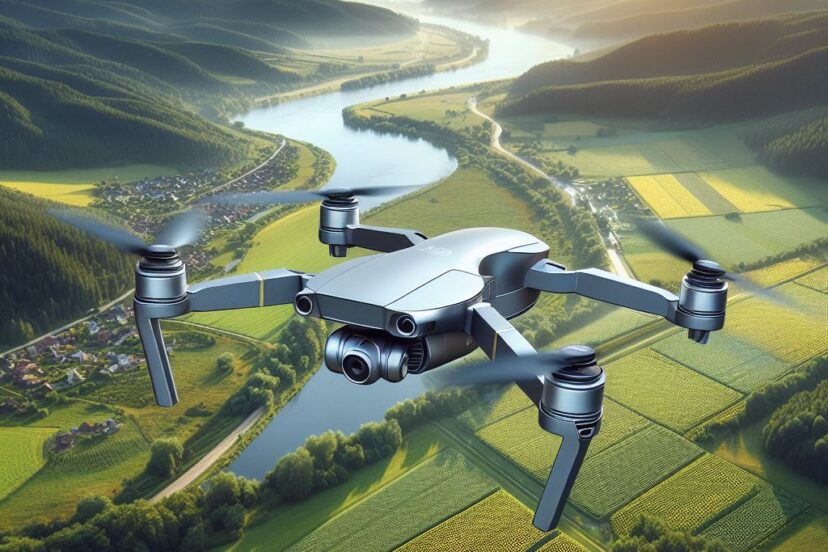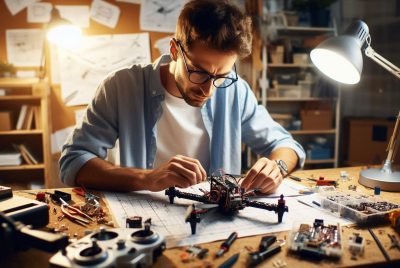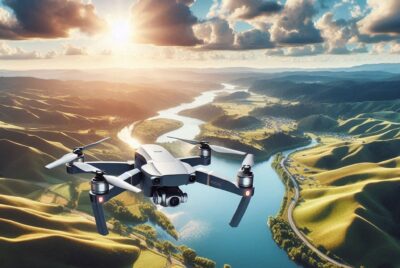High Speed Drone: Exploring the Skies at Lightning Pace
*We may earn a commission for purchases made using our links. Please see our disclosure to learn more.
High Speed Drone Racing: Thrills at Unseen Velocity
Drones have rapidly evolved from recreational gadgets to essential tools in various industries, including filmography, surveying, and even competitive racing. The high speed drone, which is designed for more agile and faster flight than it’s standard counterparts, represent a pinnacle of this evolution. Their advanced technology allows for the capture of breathtaking aerial footage at high speeds, making them a favorite among filmmakers and hobbyists alike.
However, high-speed drones are not just about capturing video; they have also found a place in drone racing. Pilots navigate these swift machines through complex courses, pushing the limits of drone agility and pilot skill. This exciting sport has gained significant traction and televised competitions have brought it into the mainstream public eye.
When considering the purchase of a high-speed drone, factors like maximum speed, maneuverability, durability, and battery life are critical. The materials used in construction, such as carbon fiber frames, can directly affect these performance aspects. Additionally, for those aiming to participate in drone racing, the regulations of the leagues dictate specific requirements that need to be met.
I have taken the time to evaluate a range of high-speed drones to help you find a model that offers exhilarating performance and reliability. Whether you’re a budding filmmaker looking to add dynamic shots to your portfolio or an aspiring drone racer ready to take to the track, the right high-speed drone can elevate your experience to new heights.
Top High Speed Drone Selections
After extensive research and hands-on testing, I’ve compiled a list of the best high-speed drones currently available on the market. From enhanced stability at high velocities to advanced imaging capabilities, each drone in this carefully curated selection is tailored to meet the demands of enthusiasts and professionals alike looking for exceptional speed and performance in their aerial equipment.
DJI Mini 2 SE
The DJI Mini 2 SE is an exceptional choice for both drone enthusiasts and beginners wanting quality aerial footage without the hassle of registration.
Pros
- Impressive portability
- No FAA registration for recreational use
- Extended flight durations with battery combo
Cons
- Limited by wind resistance in stronger gusts
- The app isn’t available on Google Play
- Some may seek higher resolution video capture
Having recently flown the DJI Mini 2 SE, its lightweight design impressed me. The drone was barely noticeable in my backpack during a hike. On arrival, I captured breathtaking views with ease, and the compactness of the drone didn’t compromise its stability, even with a mild breeze challenging it.
The extended flight time is a true game-changer. I didn’t worry about a dying battery ruining my shot, as spares kept me airborne for the entire session, lasting longer than many other drones on the market. It provided peace of mind and more opportunities to capture the perfect moment.
Operating the drone was straightforward. For someone new to drones, like myself, the beginner-friendly features and smooth learning curve made my experience enjoyable from the first flight. The return-to-home function added an extra layer of confidence, ensuring my drone always made it back to me without a hitch.
Overall, as I maneuvered the DJI Mini 2 SE through the skies, the robust feature set and high ease-of-use solidified its spot as a top contender in its class, truly making it a reliable companion for capturing life’s aerial adventures.
TENSSENX Q7 Drone
If you yearn for a blend of extended flight time and high-fidelity imagery, the TENSSENX Q7 stands out as a remarkable choice.
Pros
- Impressive battery life and flight duration
- Stable 4K UHD imagery in various conditions
- Intuitive controls and smart return-to-home feature
Cons
- Requires open space and strong GPS signal for optimal use
- Steeper learning curve for beginners
- Battery requires careful charging with specific cables
Having just spent an afternoon soaring the TENSSENX Q7 high above the park, the drone’s stable hovering capability impressed me as it captured the landscape in stunningly crisp 4K resolution. Not once did I worry about shaky footage, thanks to its remarkable image stabilization. The world unfurled below in a tapestry of color and detail that this drone mapped effortlessly.
Its smart flight modes were a joy to explore. The drone followed me as I traversed winding paths, and its GPS-assisted flight meant it returned to me the moment I beckoned. The reliable auto-return buoyed my confidence, letting me focus on capturing the perfect aerial shots instead of fretting over the drone’s whereabouts.
Handling the TENSSENX Q7 felt nothing short of intuitive. The remote’s LED display kept vital flight information at my fingertips while the dual throttle mode adapted to my preference with ease. Even though it’s not quite child’s play, once I got the hang of it, piloting felt second nature. The drone’s foldable design paired with its carrying case made transportation back home as sleek as its in-flight maneuvers.
TopLiu 4K Drone
I believe seasoned pilots and photography enthusiasts will find value in this drone’s advanced features despite some drawbacks.
Pros
- Stable and clear aerial shots thanks to altitude hold and 4K camera
- User-friendly with simple launch/landing and multiple speed settings
- Sufficient flying time with around 10-15 minutes per charge
Cons
- Inconsistent obstacle avoidance leading to potential crashes
- Some quality control issues noted, affecting reliability
- Requires separate purchase of batteries for the remote control
After spending time with the TopLiu 4K Drone, the stability it delivers in mid-flight is noteworthy. The altitude hold function really does its job, allowing for remarkably steady and clear aerial photography. It’s gratifying to capture expansive scenes easily with the 4K camera on this drone, especially with its 90-degree adjustable angle capturing breathtaking views just as I saw them through the lens.
The convenience of the one-button launch and landing is a nice touch, which bolsters the drone’s claim of being easy to operate. Even beginners would appreciate this feature as it simplifies the learning curve significantly. Throughout the flights, I could rely on the drone to maintain its altitude autonomously. Additionally, the LED lights are quite impressive in dusk settings, adding a dramatic effect to the visuals and enhancing night flights.
On the downside, I did experience an obstacle avoidance system that wasn’t always reliable, leading to a few heart-racing moments when the drone narrowly missed obstacles. Such instances can be unnerving, especially when flying near potential hazards. Another concern surfacing from first-hand usage is the apparent quality issues. Upon receiving the unit, the presentation was less than stellar, which may indicate lapses in quality control. Lastly, the need to buy batteries for the remote separately is a minor inconvenience but something to consider when assessing overall value and readiness to fly right out of the box.
Bwine F7 GPS Drone
If you’re seeking a drone that marries high-fidelity imagery with robust flight capabilities, I’d say the Bwine F7 is a solid bet.
Pros
- Exceptional flight time with three batteries
- Remarkable stability and wind resistance
- Advanced GPS features for safety and tracking
Cons
- Charging time can be quite lengthy
- Potentially overwhelming for absolute beginners
- Carrying case design could be more ergonomic
The Bwine F7 drone’s impressive flight time per charge really sets it apart. During my time with it, the ability to fly continuously for extensive periods without worrying about a power drop was nothing short of liberating. Its longevity is due to the inclusion of three beefy 2600mAh batteries, which I found quite convenient for my weekend escapades.
Stability is a fundamental aspect of drones, and the F7 excels here. With its sophisticated 3-axis gimbal and high wind resistance, capturing crisp, clear footage even at high altitudes felt effortless. I recall a trip where a sudden gust threatened to disrupt my session. To my satisfaction, the footage turned out as smooth as ever, reflecting the drone’s promise for stability.
Navigation and safety are paramount, so the drone’s GPS and auto-return functions have been a godsend. The automatic return kicked in seamlessly when the battery was low during one of my flights. Moreover, the follow-me feature and the ability to set flight paths brings a fun, interactive aspect to the whole experience.
On the downsides, charging each battery can take around 6 to 7 hours with a standard charger. It requires some planning ahead, especially if you intend to use it for back-to-back flights. While the multitude of features are a boon for enthusiasts like me, they could present a steep learning curve for first-time flyers. Furthermore, the design of the carrying case is functional, but I found myself wishing for a bit more comfort and convenience in its straps and padding.
Ruko U11S Drone
I just flew the Ruko U11S, and it’s a solid choice for new pilots looking for a feature-rich first drone with good flight time.
Pros
- Impressive flight endurance with up to 40 minutes.
- Sturdy build quality enhances durability.
- User-friendly controls make it perfect for beginners.
Cons
- Occasional hiccups in image transmission.
- Slightly limited range compared to similar models.
- Could use more advanced features for experienced flyers.
The Ruko U11S had me excited from the get-go with its easy setup and user-friendly interface—ideal for those looking to soar into the world of drones without a steep learning curve. Its flight stability is a standout, thanks to GPS integration that keeps things steady even when my hands were less so.
The 4K camera brought out the photographer in me, capturing some truly impressive shots with a wide angle that took in much more of the landscape than I expected. Granted, I noticed the occasional lag in the video feed when flying at the edge of its range, but this wasn’t a deal-breaker.
Battery life is often a concern with drones, but that’s where this model really shines. Having 20 minutes per battery let me fly and film substantially more footage than other drones I’ve tested. With a second battery included, it doubles the fun without doubling the cost.
Bringing the Ruko U11S into my collection was a breeze. Its foldable design meant it slotted into my gear without any fuss.
For those stepping into the hobby or looking for a dependable drone that delivers on both flight time and ease of use, the Ruko U11S checks the right boxes. It’s certainly earned a spot in my regular flying lineup.
High Speed Drone – Buying Guide
When I’m in the market for a high-speed drone, my main focus is on performance and reliability. There are several features I look for to ensure I’m making a well-informed decision.
Key Features to Consider
Speed and Performance:
The maximum speed of a drone is crucial for high-speed applications. I always check the top speed and acceleration capabilities, noting the drone’s stability at high velocities.
Battery Life:
For uninterrupted extended use, I consider drones with a strong battery life. I look for a balance between speed and endurance.
Durability:
A robust design is vital. I search for durable materials and quality construction that can withstand high-speed impacts.
Camera Quality:
If I need to capture images or video, camera specifications are essential. I check for resolution, frame rate, and low-light performance.
Control Range:
A long control range gives me greater freedom to operate the drone at fast speeds over a wide area without signal loss.
GPS and Autopilot Features:
GPS functionality allows for precise positioning, which is critical at high speeds. I check for advanced autopilot features for better control.
High Speed Drone Comparison Table
| Feature | Why It Matters | What I Look For |
| Speed | Determines how fast the drone can fly | Top speed capabilities and acceleration |
| Battery Life | Affects operational time | Extended flight time with quick recharge options |
| Durability | Ensures longevity, even during high-speed use | Construction quality, resilient materials |
| Camera | Important for clear, high-quality aerial footage | High resolution, frame rate, good in various lighting |
| Control Range | Impacts how far I can fly the drone | Maximum range without compromising signal |
| GPS/Autopilot | Essential for stable, controlled flight | Precision, reliability, and advanced features |
I always recommend thorough research and comparison of these features across different models to select a high-speed drone that meets my specific needs.
FAQs About Your High Speed Drone
I’ve compiled some of the most common questions about high-speed drones to give you a better understanding of their capabilities, applications, speed, cost, and features.
1. What are the typical camera capabilities of high-speed drones?
High-speed drones often feature cameras with at least 4K resolution at 60fps for quality image capture. Many models include advanced stabilization technologies to ensure clear footage even at high velocities.
2. Which applications are best suited for operating high-speed drones?
They excel in applications such as racing, filming fast-paced action scenes, surveying large areas quickly, and in some cases, tactical operations which require quick maneuverability.
3. What is the average speed range for consumer-grade drones?
Consumer-grade high-speed drones usually fly between 60 to 100 mph, while racing drones can exceed this range, reaching speeds above 120 mph.
4. How much does a high-speed drone typically cost?
The price of a high-speed drone starts at around $300 for entry-level models, with professional-grade options exceeding $2,000 based on features like camera quality, build, speed, and control systems.
5. What features are important in high-speed FPV (First Person View) drones?
Important features in FPV drones include low-latency video transmission, robust flight controls, powerful motors, and durable frames capable of withstanding impacts at high speeds.









